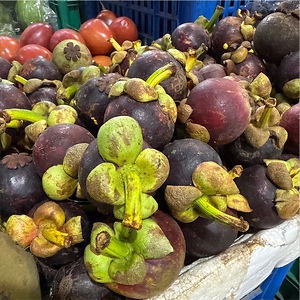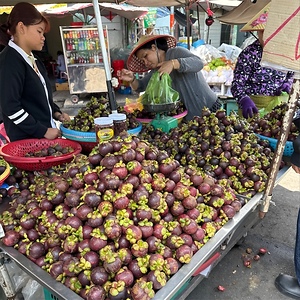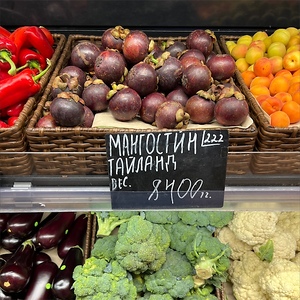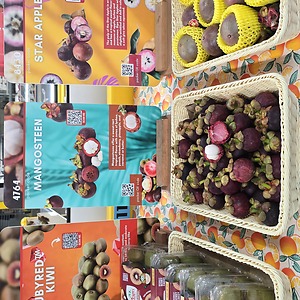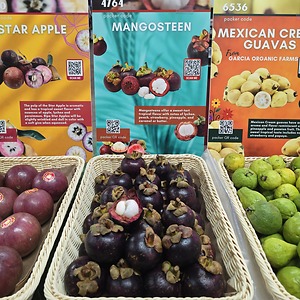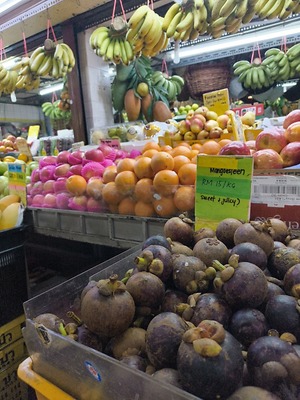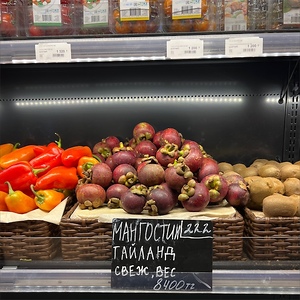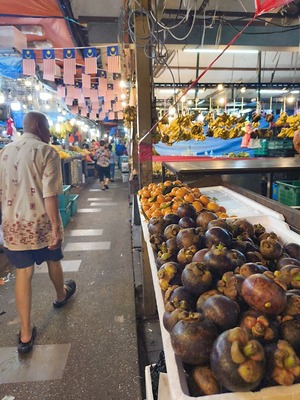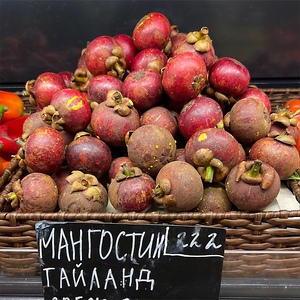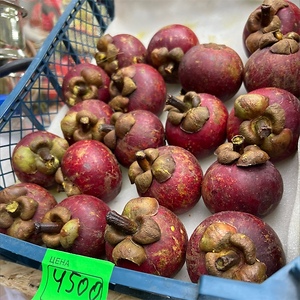

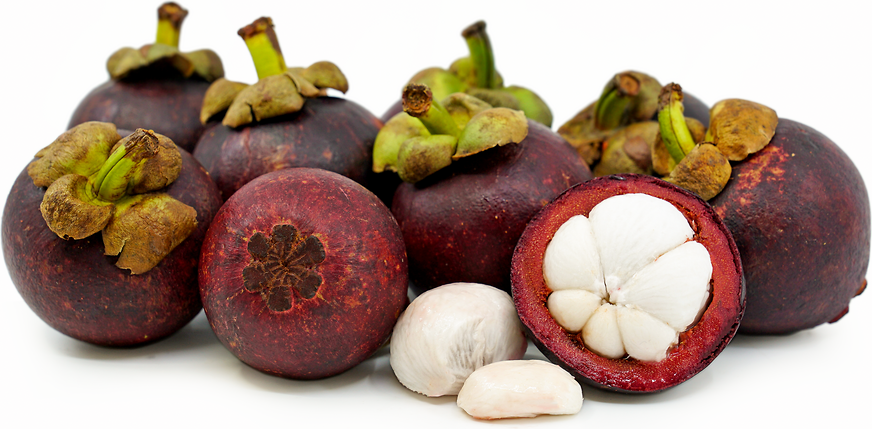
Mangosteen
Estimated Inventory, lb : 29.47
This item was last sold on : 06/29/25
Description/Taste
Mangosteen is a tropical fruit about the size of a tangerine, averaging five to seven centimeters in diameter. It has a thick, smooth, leathery, burgundy-colored shell with about four to eight flat and woody lobes arranged in a rosette at the apex. Encased in the thick skin are an average of five or six triangular floral-scented segments of white, juicy, soft flesh, which is either seedless or contains just a few flat seeds. The number of lobes at the outer apex of the fruit actually correlates to the number of segments inside. Mangosteens offer a sweet-tart tropical flavor with notes of lychee, peach, strawberry, pineapple, and caramel or butter.
Seasons/Availability
Mangosteens are available early summer through early winter.
Current Facts
The Mangosteen, botanically named Garcinia magostana, is also nicknamed the “Queen of Fruits”. The trees are cultivated primarily on small-scale farms and sold at local markets throughout Southeast Asia. Thailand is the largest producer and exporter, responsible for about half of the world’s supply, with cultivation also occurring in southern Vietnam, Burma, Malaysia, Indonesia, Sri Lanka, Singapore, and the Philippines. Outside of Southeast Asia, they have thrived especially well in southern India and northeastern Australia. They also grow on a small commercial scale in about 15 or so countries throughout Central America and the Caribbean. The United States does not grow Mangosteen commercially, but they are sometimes found at local markets in Hawaii, thanks to local growers who have nurtured this challenging tree. Until 2007, importation of Mangosteen was actually illegal in the United States over fears of introducing the Asian fruit fly to domestic crops. Today, imported Mangosteens from Southeast Asia must first be irradiated to eliminate the pest. Most Mangosteens in the US come from Thailand, where they are available year-round, and from Mexico and Guatemala, which have a peak season in the summer.
Nutritional Value
Mangosteen offers a variety of essential vitamins, minerals, and fiber, and has been used to treat an array of health concerns, from blood sugar control, to weight loss, to maintaining healthy skin, though more studies on the fruit’s health benefits are needed to support certain correlations. Mangosteen also contains a unique type of plant compound called xanthones, which have shown remarkable antioxidant and anti-inflammatory properties that may lower the risk of certain diseases. Xanthones have even been praised as having anticancer activities, and in traditional medicine, Mangosteen has been promoted as an alternative cancer treatment, thanks to its potential ability to combat free radicals and improve the immune system.
Applications
Mangosteens are most commonly used is raw applications, and are eaten fresh or juiced. Ripe fruits will be soft, yielding to pressure, and can be scored around the middle and then peeled fairly easily, despite the thick skin. Use a sharp knife to cut through the shell all the way around the middle, and lift off the top half. Be careful when removing the flesh from the other side, as the shell contains a purple juice that will stain. Mangosteens can also be canned or frozen, though some say that these methods compromise the delicate flavor and texture. Mangosteens are most often used for sweet applications like baked goods, beverages, and sorbet or ice cream, but are also used in curry dishes in parts of Thailand and Goa. Companion ingredients include, citrus, apple, pineapple, banana, kiwi, watermelon, pomegranate, butter, and vanilla. Mangosteens can bruise easily, which causes the inner flesh to harden, and they do not ripen any further once they are picked, so the fruit will start to degrade after it is harvested. Fresh fruits stored at room temperature should be consumed within a couple of days, while fruits kept in storage around 10 degrees Celsius (note that this is slightly warmer than the standard refrigerator setting of 4 degrees Celsius) may last up to a few weeks.
Ethnic/Cultural Info
European colonists stumbled upon the Mangosteen in Southeast Asia, and because the fruit spoiled so quickly, a rumor spread that Queen Victoria would reward anyone who could bring her the fresh fruit. Whether that were true or not, it was enough to inspire the Mangosteen’s widely-accepted title as the “Queen of Fruits." Her King? Another beloved Southeast Asian fruit called durian, also known as the “King of Fruits.” According to Chinese philosophy, the primary forces that influence the body’s health are elements of cold and hot, or yin and yang. Following this concept of dualism, Mangosteens supply the cool element to offset the heat of durian, and so this royal pair is often eaten together in Asia.
Geography/History
Mangosteen has been growing wild since ancient times, and is native to select regions of Southeast Asia, presumably originating in Malaysia and the Sunda Islands of Indonesia. Some evidence suggests that the tree may have been first domesticated in Thailand or Burma. It was being grown in expertly controlled English greenhouses in the mid 1800s, and its culture was later introduced into the Western Hemisphere, where it became established in many West Indian islands, notably Jamaica, and later on in the mainland of Central America in countries like Guatemala, Honduras, Panama, and Ecuador. The United States Department of Agriculture received seeds from Java in 1906 from food explorer, David Fairchild. However, cultivation proved to be difficult, and small-scale attempts made in California and Florida have not faired well. Mangosteen grows on ultra-tropical, slow-growing evergreen trees that require high humidity and heavy rainfall, are picky about elevation, and can’t withstand temperature below 4.5 degrees Celsius. Hence, Mangosteen generally does not prosper outside the tropics.
Featured Restaurants
Restaurants currently purchasing this product as an ingredient for their menu.
| Far Corner | San Diego CA | 619-549-0838 |
| Wolf In the Woods | San Diego CA | 619-851-7275 |
| UPAC Enterprise Center | San Diego CA | 619-255-7644 |
Recipe Ideas
Recipes that include Mangosteen. One
Podcasts



